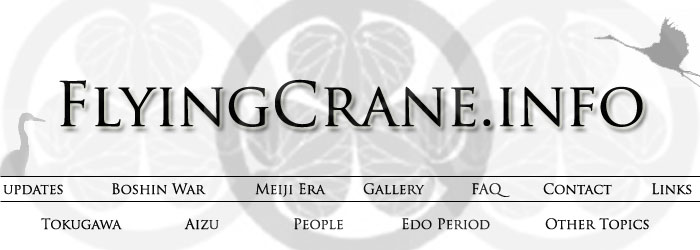| |
::BOSHIN WAR::
Hijikata Toshizo at Utsunomiya Castle
By
Armen Bakalian
The Boshin War of 1868-69 thrust many people onto Japan’s military and
political scene, all of them competing for prominence in the new system
that was about to emerge in the power vacuum left by the fallen Tokugawa
shogunate. Hijikata Toshizo was one of these men. Having achieved notoriety
in Kyoto as vice-commander of the Shinsengumi, he escaped to
Edo following the Tokugawa forces’ disastrous rout at Toba-Fushimi,
and in his role as a Tokugawa retainer, took part in the efforts to
stall the approach of the Kyoto
government’s army. After a long period of uncertainty, the new government’s
army entered Edo, and pro-Tokugawa
forces were routed at Ueno, as well as under Shinsengumi commander Kondo
Isami, at Nagareyama. Following those events, Hijikata Toshizo headed
northward.
He
joined Otori Keisuke, a commander of the former Shogunate’s infantry,
as well as men of the Aizu and Kuwana domains, and led an attack on
Utsunomiya Castle.
Utsunomiya Castle
was strategically located—it was on the northward roads leading to locations
like Aizu and Sendai,
which were becoming prime rallying locations for forces opposed to the
new government.
A question that had been on my mind for some time was the following--
a castle in Edo-era
Japan is never without an occupant.
A ruling family of Utsunomiya
was never mentioned in anything I'd read on Hijikata's attack, and this
led me to believe that perhaps it was one of the Tokugawa family's castles.
Checking the list of castles in direct posession of the Tokugawa, I
quickly found that this was not the case.
Who ruled Utsunomiya
Castle, then? Where
was its lord, and why was his castle attacked by Hijikata and Otori?
The logical step was to look for "Utsunomiya-han" ("Utsunomiya
domain") in a reference book-- in this case, volume one of Ogawa
Kyoichi's "Edo Bakuhan Daimyo-ke Jiten" ("A Dictionary
of Edo-era Lordly Families"), and Abe Akira's article on Utsunomiya-han
in volume two of the the extensive domain encyclopedia "Hanshi
Daijiten". Sure enough, I found it: Utsunomiya-han was a domain
ruled by the Toda family. As of Keio 3 (1867), it was a moderately-sized
domain of 70,850 koku, or roughly a quarter of the size of the Aizu
domain in the same year (280,000 koku). The lord of Utsunomiya was Toda Tadatomo,
who in 1868 was a young 20 years old.
The next question that arose in mind that arose was this, now that I
knew the name of the lord-- did he have any history of a disconnect
with the Tokugawa family, or a tendency toward inaction when it came
to Shogunal politics? The answer was a resounding no-- Tadatomo held
high positions in the Tokugawa administration, both as a Master of Ceremonies
(soshaban) and a Magistrate of Temples and Shrines (Jisha-bugyo). He was appointed to these
posts as of the 25th day of the 7th month of Keio 3 (1867), so that
doesn't leave much room for him to do anything antagonistic to deserve
an attack by the former Shogunate's infantry.
Looking at a timeline of the actions of the lords of Utsunomiya
throughout history, I found the following: Toda Tadatomo was, on the
15th of the 3rd month of Meiji 1 (1868), in Otsu,
on his way to Kyoto,
to transmit Tokugawa Yoshinobu's apologies to the Imperial Court, when he was arrested and
detained. Utsunomiya was thus left lordless,
until the 6th of the 4th month, when his predecessor, Toda Tadayuki,
returned to Utsunomiya from Edo,
and officially submitted to the new government.
This answered my question of why exactly Hijikata and Otori attacked
him. But I read further-- about a week after Tadayuki returned, a peasant
riot (a "yonaoshi-ikki", as it's known in Japanese)
broke out, and hard on the heels of the riots, only a handful of days
later, Hijikata and Otori arrived and took the castle on the 19th of
the 4th month. However, the new government attacked Utsunomiya
Castle a handful of days later,
on the 23rd. Years later, Otori wrote an account of the events, which
was published in the magazine "Kyu Bakufu" in Meiji 30 (1898),
in which he said that Hijikata was among the injured leaders of the
force operating at Utsunomiya. Hijikata was
subsequently taken to the Higashiyama hotsprings within the Aizu domain
for treatment.
On
a rather interesting note, the gojintai
(divine image) from Toshogu Shrine was removed three days after the
Kyoto government’s forces took Utsunomiya Castle,
which was uncomfortably close for the forces in the north. Another effort
was made by the opposition forces to take a strategic target; namely,
Shirakawa Castle, but this too also ended in failure
by the 5th month of Meiji 1.
Just a little example of the level of detail that I am beginning to
discover in my research on the Bakumatsu.
-A.M.B.
Bibliography:
Abe
Akira. “Utsunomiya-han,” in Hanshi
Daijiten, Volume 2, edited Kimura Motoi. Tokyo:
Yuzankaku, 1990.
Gekidosuru Aizu Boshin Hen.
Vol. 5 of Aizuwakamatsu Shi.
Tokyo:
Kokusho-kankokai, 1981.
Ogawa
Kyouichi. Edo Bakuhan Daimyo-ke Jiten, Volume 1. Tokyo: Hara Shobo, 1992.
Otori
Keisuke. “Nanka Kiko,” in Kyu
Bakufu 1 (1898): 20-58.
All
contents on the site unless otherwise noted are copyright 2006-8 Armen Bakalian
Information on this site may not be duplicated elsewhere
without the explicit permission of Armen
Bakalian.
|
|

